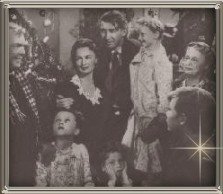A Tribute To my All Time Favorite Movie

 |




By Roger Ebert
Reprinted from Chicago Sun Times (without permission)
If there is a legal problem with me posting this,
email me.
The hero, of course, is George Bailey (Stewart), a man who never quite makes
it out of his quiet birthplace of Bedford Falls. As a young man he dreams
of shaking the dust from his shoes and traveling to far-off lands, but one
thing and then another keeps him at home--especially his responsibility to
the family savings and loan association, which is the only thing standing
between Bedford Falls and the greed of Mr. Potter (Lionel Barrymore), the
avaricious local banker.
George marries his high school sweetheart (Donna Reed, in her first starring role), settles down to raise a family, and helps half the poor folks in town buy homes where they can raise their own. Then, when George's absentminded uncle (Thomas Mitchell) misplaces some bank funds during the Christmas season, it looks as if the evil Potter will have his way after all. George loses hope and turns mean (even his face seems to darken, although it's still nice and pink in the colorized version).
He despairs, and is standing on a bridge contemplating suicide when an Angel 2nd Class named Clarence (Henry Travers) saves him and shows him what life in Bedford Falls would have been like without him.
Frank Capra never intended "It's a Wonderful Life" to be pigeonholed as a "Christmas picture." This was the first movie he made after returning from service in World War II, and he wanted it to be special--a celebration of the lives and dreams of America's ordinary citizens, who tried the best they could to do the right thing by themselves and their neighbors. After becoming Hollywood's poet of the common man in the 1930s with an extraordinary series of populist parables ("It Happened One Night," "Mr. Deeds Goes to Town," "Mr. Smith Goes to Washington," "You Can't Take It With You"), Capra found the idea for "It's a Wonderful Life" in a story by Philip Van Doren Stern that had been gathering dust on studio shelves.
For Stewart, also recently back in civilian clothes, the movie was a chance to work again with Capra, for whom he had played Mr. Smith. The original trailer for the movie (included on the Criterion disk) played up the love angle between Stewart and Donna Reed and played down the message--but the movie was not a box office hit, and was all but forgotten before the public domain prints began to make their rounds.
"It's a Wonderful Life" is not just a heart-warming "message picture." The conclusion of the film makes such an impact that some of the earlier scenes may be overlooked--such as the slapstick comedy of the high school hop, where the dance floor opens over a swimming pool, and Stewart and Reed accidentally jitterbug right into the water. (This covered pool was not a set but actually existed at Hollywood High School). There's also the drama of George rescuing his younger brother from a fall through the ice, and the scene where Donna Reed loses her bathrobe and Stewart ends up talking to the shrubbery. The telephone scene--where an angry Stewart and Reed find themselves helplessly drawn toward each other--is wonderfully romantically charged. And the darker later passages have an elemental power, as the drunken George Bailey staggers through a town he wants to hate, and then revisits it through the help of a gentle angel. Even the corniest scenes in the movie--those galaxies that wink while the heavens consult on George's fate--work because they are so disarmingly simple. A more sophisticated approach might have seemed labored.
"It's a Wonderful Life" did little for Frank Capra's postwar career, and indeed he never regained the box office magic that he had during the 1930s. Such later films as "State of the Union" (1948) and "Pocketful of Miracles" (1961) have the Capra touch but not the magic, and the director did not make another feature after 1961. But he remained hale and hearty until a stroke slowed him in the late 1980s; and he died in 1991. At a seminar with some film students in the 1970s he was asked if there were still a way to make movies about the kinds of values and ideals found in the Capra films.
"Well, if there isn't," he said, "we might as well give up."
Go here to another a link I found that Roger wrote about IAWL.

It would be Wonderful if you would
Sign the IAWL Guestbook
and share your favorite IAWL Moment!
Read the comments that were
submitted


